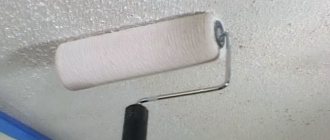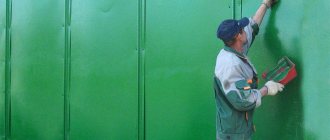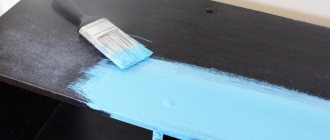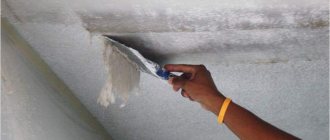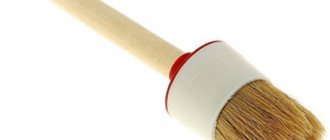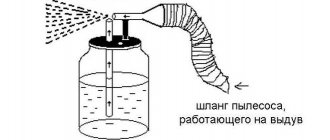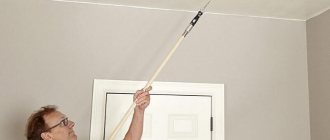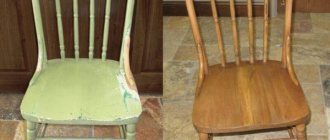The topic of our article is painting the ceiling. This seemingly simple episode of repair raises a lot of questions. How to level the surface? What paint should I buy? Which roller is best to paint the ceiling? Let's take a short excursion into the theory and practice of repair.
Let's try to find out more about how and what ceilings are painted with.
Characteristics of paint rollers
The roller consists of three main parts: a handle, a metal rod and a rotating roller. The comfort of the master during work depends on the type of tool handle. The quality of the rod affects the reliability. The rotating roller consists of two elements - a bushing with a core and a fur coat (plush). Plush is the most important element, as it determines the quality of the future coating.
When choosing a painting tool, professionals focus on several characteristics:
When painting rough and uneven surfaces, as well as corners, rollers with long pile will provide excellent results. An even, smooth layer of paint and varnish material and the absence of splashes are guaranteed by short-pile plush. To paint deep uneven surfaces, use lined rollers.
The material from which the paint roller coat is made is responsible for working with certain types of paintwork materials. Plush for high-quality, professional rollers is made of polyamide, microfiber, nylon, velor and felt. There are also foam rubber (polyurethane foam) rollers, both with and without flock coating.
Choosing a roller for painting walls: pile length
There is a rule: the rougher the surface of the walls, the longer the pile of the “coat” should be. The roller you plan to use to paint a textured surface (for example, textured plaster or imitation wallpaper) should have a long pile. Long pile paints well various grooves, dents, and depressions. For smooth walls you need a short nap roller! This is important: if you use a long-haired roller on a smooth surface, smudges, streaks and uneven color may occur.
Selecting a paint roller by paint type
To obtain a high-quality coating, it is necessary to take a responsible approach to the selection of paint coat material. The role of the main criterion when choosing plush is given to the type of paintwork materials. Let's consider the most optimal combinations.
Water based paints
When working with water-based paints, the highest quality material today is polyamide. This synthetic fiber is obtained from petroleum refining. It is characterized by high strength, does not stick together when rolling paint, and picks up, holds and releases paintwork well. At the same time, it is easy to clean, which significantly increases the service life of the roller.
In the STORCH catalog of professional painting tools, these rollers are presented in two lines: MULTICOLOR and EXPERT.
MULTICOLOR polyamide plush rollers have very good absorption and paint release, which increases productivity. At the manufacturing plant, the fur coat is washed for an hour at a certain water temperature in a special machine. Thanks to the preliminary wet treatment, the roller is lint-free. However, before starting work, we still recommend moistening it.
Roller STORCH polyamide MULTICOLOR
MULTICOLOR polyamide rollers are compatible with all types of water-based paints intended for painting facades and walls. To work with varnishes, use short-haired painting tools from this line.
Professional painting tools from the EXPERT line are recognized by professionals as one of the best when working with water-based paints. They are made from one-piece polyamide fiber "endless thread". When painting, the pile does not separate and does not fall on the surface being treated, which allows you to achieve excellent quality of the coating.
Roller STORCH polyamide Expert, endless thread
EXPERT rollers are ideal for applying dispersion, latex, silicate paints, and silicone colored resins. The short-haired painting tools in this range are good for working with water-based acrylic/polyurethane varnishes, as well as alkyd varnishes where a perfectly smooth finish is not required.
Solvent based paints
The best option for working with solvent-based varnishes and paints are rollers with plush made of natural sheep wool (velor). This material is not afraid of aggressive chemical compounds.
Roller STORCH velor
STORCH professional velor rollers do not contain synthetic impurities, so their shelf life is significantly longer than that of conventional painting tools. The short pile allows for a high-quality finish to be applied to a smooth surface. Rollers made of 100% sheep wool are ideal for working with alkyd varnishes.
Impregnations, primers and antiseptics
STORCH recommends using microfiber paint rollers (micro-fine interwoven threads) to apply these materials. They absorb the maximum amount of material, hold it perfectly and transfer it to the surface in an even thin layer, without forming splashes. Microfiber plush is lint-free, easy to clean and wear-resistant.
Roller STORCH microfiber
These rollers have proven themselves to be excellent in working with impregnations, antiseptics, primers and other liquid paints and varnishes.
Thick coatings
Two-component varnishes and paints and thick coatings are best applied with nylon rollers. Plush made of nylon endless threads perfectly absorbs materials with a high viscosity coefficient and allows you to achieve high quality dyeing through uniform distribution.
Roller STORCH nylon
STORCH professional nylon rollers are additionally stabilized and compacted, which improves their painting performance and ensures excellent quality of the future coating.
Water-based and solvent-based varnishes
To work with different types of varnishes, STORCH offers a choice of four professional painting tools.
Superfein polyurethane foam roller is a new word in surface varnishing. It is distinguished from other foam rubber painting tools by its super-fine structure and maximum density. The result is a perfectly smooth, bubble-free coating.
Roller STORCH polyurethane foam Superfein
Bubble-free coverage is also provided by professional SoftForm Pro paint rollers. They are made from finely porous dense foam rubber, therefore they are characterized by high absorbency and uniform release of the material. Special cone-shaped recesses made at the ends of the tool allow you to achieve perfect varnishing without streaks. Thanks to them, when rolling, a minimal amount of varnish is released from the edges of the roller and the finishing surface is unprecedentedly smooth and uniform.
Roller STORCH polyurethane foam with end grooves SoftForm Pro
The SoftForm flock-coated roller is made of high-density polyurethane foam and has a fine-porous structure, which allows it to absorb and release varnish much more efficiently than other painting tools. In turn, the flock fibers prevent the formation of bubbles. As a result, you get an absolutely smooth coating without a single defect.
Roller STORCH polyurethane foam with flock coating and SoftForm end grooves
Separately, we can highlight the innovative monofilament plush made of polyester, which is ideal for all types of varnishes: both water-based and solvent-based. It has good coverage and does not leave lint. Filt rollers have proven themselves in working with thick paints and paintwork materials of the new generation.
Roller STORCH filt polyester
Operating principle of a roller with automatic paint supply
The principle of operation of a roller with a paint reservoir is actually simple. The roller is located in a cavity into which a certain amount of water-based paint is supplied using a hose, after which the pigment flows from the cavity onto the surface of the roller. There is some inconvenience, which lies in the fact that often the entire structure has to be kept in a horizontal position.
To implement the process of supplying the coloring pigment, a pump operating from the network or from a pre-charged battery is used. Models with automatic dye supply are produced by many well-known brands, which indicates the reliability and practicality of this type of device.
It is advisable to use such a roller in cases where it is necessary to cover a fairly large surface.
Attention! In small areas, this approach is not practical, since the process of washing the device after use does not justify the scale of the work.
To use a roller, you need to dilute the base with water in a certain ratio, mixing the two substances in a special container. Most often, 10-20% water is added, due to which the paint application becomes more uniform, the consumption of coloring pigment is reduced, and the surface area to be coated is increased. It is precisely the homogeneous mass obtained by dilution that reaches the roller through the hose.
The choice of roller depends on the type of surface and its area.
When choosing a painting tool, also pay attention to the system for attaching the roller to the telescopic extension, the structure of the core and the clasp. Read about these features in the design of rollers in one of the following articles.
STORCH has extensive experience in the development and creation of new generation painting tools aimed at solving all kinds of problems. The range includes more than 40 types of professional rollers made from high-quality materials. Our painting tools are faithful and reliable assistants, allowing you to achieve first-class painting of surfaces of any type with any paintwork materials.
You can get acquainted with the entire range of STORCH rollers, and also purchase them on the company’s website (online store) - https://www.storch.ru
It is more convenient and faster to choose the right plush using the booklet-table. Open the booklet developed by STORCH by following the link Booklet “Paint rollers. The right choice"
Source
Which roller is best for painting?
Painting walls and ceilings with various types of paints as decoration has been used for years. For an aesthetic appearance, it is necessary to create a smooth and uniform surface. Uniform application of finishing paint is impossible without a reliable tool. Working with a brush when treating large areas is time-consuming and impractical, so a roller is used to paint walls, ceilings and other surfaces. This tool is often used by both professionals and beginners, as it allows you to make cosmetic repairs to walls in the shortest possible time.
Rules for painting the ceiling
The quality of painting will depend not only on the correctly selected coloring composition, but also on the correctness of coloring. Experts offer their recommendations, following which you will receive a high-quality and evenly painted ceiling:
- Apply paint in at least two layers. In this case, cover the ceiling from the window with a second layer, then small flaws will be invisible;
- When painting, do not take breaks; try to paint the entire surface in one go;
- You can check the uniformity of coloring by looking at the ceiling at an oblique angle;
- when paint deposits form on the ceiling, you first need to rub them with a washcloth, and then apply a layer of paint to these places again;
- Before wearing the second layer, you need to wait until the first one is completely dry.
On a note! If you work with different rollers (on one layer - one tool, on the second - another), the paint will lie more evenly.
Coloring is done as follows:
- When using a ceiling roller, work in one direction only. Apply the paint in the shape of the letter “W”, with the next stroke extending 2-3 cm over the previous one.
- Apply the second coat of paint perpendicular to the first.
How to properly paint the ceiling is described here.
Pros and cons of working with a roller
Using a roller to paint any walls has many advantages over classic brush painting:
However, there are some disadvantages to this tool:
However, if you take into account all the features of working with the tool, you can save money and paint everything that needs to be painted.
The range of rollers is quite large: for each operation you can select a tool of a certain type and design of the element being painted.
There are several main types of rollers for painting ceilings and walls:
According to their purpose, rollers are divided into:
Each option is selected for specific tasks, so you cannot purchase one roller for all surfaces.
Painting with a roller can be as fast as painting with a spray gun
Most DIYers consider a paint sprayer because they think they will finish the project in the least amount of time. It is not always so. When you use a paint sprayer, the time you save in applying paint will be spent assembling your tools and cleaning them thoroughly. The prep work takes much longer than with a roller, so the total project time ends up being about the same.
Another thing to consider is that if you get interrupted or get tired of painting, you can safely stop the process and continue the next day. You can quickly wash your roller or put your tools in a ziplock bag to keep the paint from drying out before you get back to work. But once you've filled the spray gun with paint, you work until you're done because paint left in the sprayer hose or gun will dry out and cause a clog.
Criterias of choice
Many people wonder: which roller to choose for painting the ceiling or walls. There are eight main aspects to consider when choosing a roller:
Don't forget to purchase a cuvette. This small trough allows you to apply paint evenly and remove excess paint from the roller. It is reusable, so it will be useful for further repairs.
Dimensions
The rollers differ not only in design, but also in size. The instruments are classified according to their sizes:
There are also separate rollers for working with bitumen and structural paint.
Foam rubber
The cheapest option, suitable for water-based paints for interior work. Its main drawback is its low resistance to aggressive compounds. The foam roller is not suitable for oil and alkyd paints.
Velours
The velor roller is chosen by those who value quality. It allows you to create smooth surfaces if the painter is professionally trained. If there is none, it’s worth practicing, as all the defects will stand out.
Fur varieties are used for applying enamel, oil, latex paints and silicates. The shorter the pile of such a fur coat, the smoother the surface will be. These rollers are considered classic, since their history goes back to the past, when our grandparents painted fences and walls of houses with them.
Polyamide thread
Rollers with threads instead of a coat allow you to apply paint quickly, but not too carefully. In this case, the movements should not be sharp, since paint tends to splash from the roller.
Painting a wall with a roller
Wallpaper for painting does not lose its relevance, so you should choose a special version of the tool for it. Deciding which roller to paint the wallpaper for painting depends on the type of base and the type of paint used. The process consists of main stages:
Each stage is important to obtain the desired result.
Preparing for work
Before painting, it is important to prepare the surface. It is necessary to eliminate all defects: chips, cracks, unevenness. This can be done with sand-cement mortar and putty. If it is not possible to level the walls, they can be covered with plasterboard. It solves the problem of unevenness and insulates the structure of the building. To protect baseboards and trim, you need masking tape.
Before starting painting work, you should prepare everything necessary for effective work. In addition to the basic elements (paint and roller), you will need:
All surfaces of furniture and other objects located in the room should be covered with protective film. If possible, care should be taken to ensure ventilation. It will remove toxic fumes resulting from the evaporation of chemicals.
Painting work
Work should begin by pouring the dye into the container. The paint should be diluted according to the manufacturer's instructions. Any experiments can negate all the efforts made: the paint may become too liquid or thick.
Then the roller is lowered into the working composition for impregnation. The tool is then rolled over a grooved tray to remove excess.
Visually, the entire surface should be divided into several zones. When processing large areas, it is advisable to roll the roller diagonally. This technology allows the composition to be evenly distributed by covering the first layer with a second layer. You need to roll it out so that the layer is thin. Professionals believe that it is better to make three thin layers than one thick one.
Do not linger in one place to avoid swelling of the paint and changing the surface texture from smooth to rough. If an area is skipped, it is better to wait until the surface dries. Only after this can you begin re-painting.
Application technology
The technology of painting with a roller differs from the methods of applying paint with brushes. Coloring should begin from the top, moving down. Painting begins from the window for a more uniform application.
The square-cluster coloring technique is considered optimal for beginners. These are kind of tricks to make a large canvas piece by piece. It involves dividing the entire surface into 1 meter sections (0.7 m if necessary). The squares are filled in gradually. Work can be done horizontally or vertically.
After the first coat, streaks (the borders of the squares) may be visible, but they will quickly disappear after applying a second coat of paint.
The saturation of the coating depends on the number of layers. Paints of different composition require individual application: acrylic and water-based paints should be applied in 3-4 layers with an interval of 12 hours, oil paints can be applied in 2-3 layers.
Therefore, before painting, you should study the instructions for using a particular composition.
End of work
The remaining paint after work is isolated from direct contact with air. The water-based emulsion may dry out in 2-3 days. Oil paints also do not tolerate such contacts and lose their properties, so they need to be placed in a jar with a tight-fitting lid. Do not add paint to a can of untouched paint. Such mixing will negatively affect its quality.
Masking tape must be removed from trims and baseboards. This must be done before the painted layer has completely dried so that there is no streak left. After the paint has completely dried, you can remove the film from the furniture and throw away the used cape.
You can install lamps, sockets and switches on the painted surface.
Instrument care
For long-term further use, you should carefully monitor the tool.
For this purpose, the following materials are prepared:
For each roller you should prepare a bucket of warm water. Add a couple cups of softener to each and mix until smooth.
You can clean the roller with water or dishwashing liquid. Before cleaning, the remaining paint on the roller is rolled out onto newspapers if you place an improvised canvas on the floor.
The sequence of actions is as follows:
If work was carried out with oil paint, alcohol or turpentine should be used. These are aggressive substances that can cope with even severe pollution.
After cleaning, the roller is hung on a nail or hook to dry. If this is not done, the roller pile will most likely lose its original shape and become unsuitable for use. When the instrument is dry, it is covered with aluminum foil or plastic film to protect it from dirt and dust.
If repairs are temporarily forced to stop, the roller should be placed in a plastic bag and placed in the refrigerator. This will preserve the quality of the instrument. However, when storing at low temperatures, it may be necessary to defrost the roller first.
Painting with a roller is a complex and time-consuming stage of repair. However, with a competent approach, the result will be pleasing to the eye, and the costs are not so high compared to the purchase of other finishing materials. The main thing is to follow the technology and not skip the preparatory stages. Painted surfaces will create an atmosphere of warmth and comfort in a residential space, as well as rigor and conciseness in an office building.
Source
How to clean a paint tray?
It is better to use running water, or pour water into a suitable container, then immerse the bath
into the water, you can rub it a little with a brush or sponge, then rinse
the bath
in like.
If water does not help, then you can use white spirit, solvent and even acetone for some types of paints
.
Interesting materials:
Who can you guess in Akinator so that he doesn’t guess? Who should be blamed for Life Is Strange? Who to Blame for Life Is Strange? Who did Presnyakova give birth to? Who is Podolskaya waiting for? Com port on PC? Com ports for Windows 10? Who wants what Sophia or Sophia? Who needs what Victoria? Who gets dormitory accommodation at the university?
Paint roller: general characteristics
The type of fur coat depends on the purpose of the roller. This is the part where the paint is applied. It can be foam rubber, velor or fur (faux or natural fur). Fur coats also differ in the length of the pile.
The clasp is a metal curved base on which the roller is attached.
Pen. It is usually made of plastic, rubberized material or wood. Now special depressions are made on it for ease of holding. Such a handle will not slip out of your hands while working.
As a rule, they sell rollers with fur coats already put on the roller. But you can also purchase the components separately. This option is suitable for large-scale construction work, when it is more economical to simply replace it with a new one when the coat wears out.
Sizes and types of paint rollers
In turn, paint rollers differ in the length of the coat, the width and diameter of the working surface.
The handle length of the rollers also varies - from 35 cm to 50 cm. If necessary, you can purchase a telescopic handle. It will lengthen the roller, and then you can use it to paint a surface that is high up without using a stepladder.
Roller models
There are several types of paint roller
Material for roller coats
The types of material from which roller coats are made are quite varied.
Attaching the roller coat to the roller
There are several types with which the fur coat is attached to the roller.
How to choose the right paint roller
As already mentioned, each type of roller has its own purpose, based on its characteristics. But the manufacturer indicates on the packaging only the types of paint that a particular roller can “withstand.” When choosing a roller, first of all, proceed from what kind of work you need it for and how much surface area you are going to cover with it.
If you are going to paint a small area, a small mini roller will do the trick. For walls and ceilings, you need to take a medium-sized universal roller (midi). The roller must first of all be of high quality. To avoid unpleasant incidents during painting:
If you are going to work with paints of several colors, then it is better to purchase one high-quality roller and several replacement coats for it.
Which roller to choose for painting walls and ceilings
Why do you need a long-nap roller?
Where is a velor paint roller used?
What is a foam roller for?
Source
Guide to choosing a paint roller
Let's try to make it as simple as possible. The most important question that arises when choosing a paint roller is how to choose it?
Figure 1 Types of rollers
Firstly , to do this we need to determine exactly what types of work we need it for. That is, what surface will need to be painted or treated (Figure 1).
If you evaluate all types of surfaces, then you can conditionally define only 3 types:
- smooth (prepared walls, windows, interior and garage doors, etc.);
- rough (medium roughness);
- rough (rough walls, stones, untreated wood, in a word, all those that have a clearly uneven surface).
For rough surfaces, choose a wall paint roller with the longest possible pile, ranging from 12 to 25 mm, for example façade or synthetic. For rough surfaces - fur from 4 to 12 mm, for example from the girpaint, multicolor, nylon, microfiber, lamb series. For smooth ones - up to 4 mm, these include velor, moltoprene, foam rubber. You need to understand that any rollers are suitable for smooth surfaces, but if your surface is flat, and you took a roller with 25 mm pile, then although you will do your job, the consumption of paint and varnish material will be large. This is impractical, although not tragic.
Figure 2 Rollers large, midi, mini
Secondly , we estimate the volume and area of work. Rollers and rollers are divided by size (Figure 2):
- large , case diameter greater than 48 mm, length from 180 to 250 mm;
- midi , case diameter from 30 to 48 mm, length from 100 to 150 mm;
- mini , from 15 to 30 mm, length from 55 to 150 mm.
Large paint rollers are used for large surfaces, such as walls and floors in a home. Midi are needed for an area commensurate with the size of the door opening or for painting the door itself. And mini ones are taken to tint window frames or narrow surfaces, where large rollers will not fit in size. It is not difficult to make a selection of paint rollers for paint on the website www.3brothers.ru in the painting tools section.
Figure 3 Types of paints
Figure 3 Types of paints Thirdly , we remember what paintwork materials we treat the surface with (Figure 3). It is important to consider what paints the roller will be designed to work with.
- for aggressive coatings, that is, containing solvents, enamels, varnishes, oil paints;
- for water-dispersion , water-emulsion, acrylic, primers, impregnations;
- for plasters and structural paints.
For aggressive paints and varnishes, select any rollers whose coating includes polyamide . It is quite wear-resistant and suitable for painting with any type of paintwork material. The structure of the pile and threads allows painting of rough and rough surfaces. For example, paint rollers “Multicolor”, “Sintex”, “Elitecolor”.
For water-dispersion paints, we select a polyacrylic . Polyacrylic and polyamide are similar in structure, but the former is less wear-resistant. For example, rollers from the “Nylon”, “Girpaint”, “Velour”, “Premium” series.
Polyester rollers are used for painting rough protective coatings . The fiber resembles cotton wool or padding polyester. It absorbs and retains coloring paints well. After it there is no lint left on the paintwork. The material is homogeneous and durable. For example, "Moltoprene".
Polyester foam (foam rubber) is selected for working with water-based or adhesive paints, because polyester is corroded by solvents. They are part of enamels, varnishes and oil-based paints and varnishes. If you use a foam roller for varnish, then inclusions from the roller will remain on the surface. A Microfiber roller, which contains polyester . “Microfiber” is also suitable for acrylic, primers, and impregnations.
Faux fur is suitable for aggressive environments, such as enamels , varnishes , and oils . For these purposes, select a fur paint roller.
Structural rollers with a pattern are chosen for plastering and adding decorative patterns.
Figure 4 Production of paint rollers
Fourthly , when we figured out what surface we are processing and what roller we will paint with, all that remains is to choose a roller based on quality and price.
The cost and quality of the roller is influenced by the method of applying the coat to the frame and the integrity of the coat itself.
We divide into 3 types of rollers according to the method of attaching the fur coat:
- pasted;
- thermally pressed;
- put on.
Put on - the coat of these rollers is simply put on the frame without glue or heat setting. At the ends of the roller there is a plug for fixing the fur coat. Such rollers are durable and inexpensive, but are of lower quality, because... The fur coat is sewn and has a seam. This reduces the quality of work.
Seamless rollers are produced by gluing . To achieve this, a strip of fur is glued at a slight angle to the surface of the frame. The edges of the strip are joined into a joint and no seam is formed. The advantage of such rollers is that the absence of a seam provides high-quality surface treatment and they are not expensive to produce. But they have a short service life due to the gradual destruction of the adhesive composition by aggressive types of paintwork materials.
The best way to attach a fur coat to a roller is considered to be soldering it into the frame through heat treatment . The fur coat of such rollers is solid and seamless. This gives durability and the same high quality in surface treatment. But this method of fixing a fur coat is the most expensive in production.
The choice of a good paint roller at this stage depends entirely on the financial component. There is only one piece of advice - if you need a roller for a one-time job and for a short period of time, choose one on the website in the middle price group.
Figure 5 Helpful Hints
And finally, some tips on working with rollers:
- To reduce splashes when working with a foam roller, you do not need to actively move it over the surface;
- Working with a velor roller requires experience. Practice in advance on any suitable surface;
- Be sure to use a paint tray. It is much more convenient to roll out paint in it than on cardboard or paper;
- We wash the new roller with soap and water and get rid of unnecessary lint;
- To work with latex paints, dampen your roller before starting;
- Rollers with a larger diameter are less dirty;
- One roller, many colors, start with a light tone;
- An extension handle for rollers will make painting walls and ceilings easier;
- If you need to step away for a while, wrap the roller so it doesn’t dry out;
- After work, rinse the roller with solvent, or if the roller is for water-dispersed paints, then with water.
The online store www.3brothers.ru presents a wide selection of rollers for painting any surface. If you have difficulty choosing, then call the phone number on the main page of the site. The manager will help you select the product and place your order.
DIY door painting
Doors are the same planning element as walls, ceiling or floor. During operation, gradual wear of the outer planes of the door frame and leaf occurs. To extend the service life and restore damaged areas, it is recommended to paint the doors every 5 - 7 years. Why it is useful to familiarize yourself with the principles of applying protective coatings to various types of products.
Types of paints for doors
Don't be intimidated by the huge variety of coloring enamels. The packaging always contains detailed instructions for using a particular coating. And the first thing you need to pay attention to is what material the paint is intended for. Improper use leads to rapid wear of the door coating - loss of shine, peeling and cracking.
There are four types of coatings for wooden products:
Alkyd enamel has a short service life
Water-based acrylic enamels have a huge number of colors and shades
Nitro paint can only be removed with a special solvent
Oil paint takes a long time to dry
All types of paints described are used for metal doors, but there are also those specially designed for steel surfaces. These include:
Hammer paint protects metal from corrosion, mechanical stress and temperature changes
Forge paint imitates a coating of precious metals on the surface of doors
Key points in painting the ceiling
The first stage of painting work begins with the purchase of paint. It is best to choose water-based dyes for painting ceilings. They are practically odorless, dry quickly, are easy to apply, immediately improving the appearance of the ceiling surface. The instructions on the can will help you make the right choice of paint, where you will also find information about the method of diluting the composition. As a rule, ordinary water is used as a solvent, which is added to the jar in an amount of approximately 10% of the total volume.
But most often the emulsion is already sold ready-made, and it can be immediately used for coloring.
Advice! To make painting easier, add a small amount of paint to the paint tray. Then splashes will not form, and the paint in the required amount will be collected on the roller.
Water-based paints are made on acrylic, silicate, silicone or mineral bases. For example, an acrylic coating is not completely washed off with water, since it contains glue and latex, which ensures reliable adhesion to the surface being painted.
Water-based paint dries much faster than oil paint. And this is an absolute plus. For the bathroom or kitchen, choose silicone-based compounds that tolerate temperature fluctuations well and are resistant to mechanical stress.
A detailed report on what paint to use for the ceiling, the best manufacturers and compositions.
Choosing a painting tool
In factory conditions, sophisticated automatic equipment is used to cover doors. The top layer is not only painted, but also polished. At home, hand tools are used. All brushes and rollers are different and serve different purposes. For example, a brush with long bristles is better at painting hard-to-reach recesses, but splashes the paint on a flat surface, while a roller with short “hair” allows you to save varnish by stretching it more evenly over the entire surface. For painting you will need:
Paint brushes differ from each other in the width and length of the bristles
The tray for diluting paint is selected according to the width of the roller
Paper tape will protect surfaces from paint.
You cannot use a foam roller for painting with enamels. The fact is that this type of tool is intended only for water-based paint. If you dip it in nitro enamel, it will simply dissolve or become deformed. As a result, pieces of foam rubber will remain on the surface of the door.
In addition, it is necessary to provide for the availability of plumbing tools necessary to remove the door leaf from the hinges:
An electric screwdriver significantly speeds up the process of installing and dismantling the door leaf
The place for the procedure is chosen to be spacious and dry, with good ventilation. When using paint with a strong odor (alkyd or nitro enamel), it is recommended to use a respirator to protect the respiratory organs. If the coating is applied using a compressor or spray gun, you should take care to protect nearby walls and furniture from sprayed paint. This can be done well with plastic film, which is used to carefully cover all the objects in the room.
Advantages of a roller with automatic paint supply.
Of course, such an auxiliary element has a number of advantages, and it is on the basis of them that one can conclude whether you need such equipment, or whether it is better to postpone the purchase of the device for some time.
- The first and main advantage is the fact that most of the devices produced by different brands are safe with regard to splashing and the formation of drops on the material at the time of applying the coating itself.
- The second advantage is the fact that they greatly increase the working length. Often it can be stretched from 40 cm to 120. What does this mean? It's simple, you will be able to reduce paint consumption and apply it to a larger surface than you would with a standard brush.
- All models are modern, which guarantees that cleaning such a device will be simple and effective due to the universal connections to the water tap. Some models do not have universal connections, however, the kit includes quite practical and reliable adapters.
- Models often have a long cord, which allows you to paint large areas at a time.
- The application of paint using this model will be uniform, which means that no special skills are needed for this process.
- The devices also imply the fact that the user has a free choice of any water-based paints.
- Such rollers are practical, since most models are equipped with comfortable handles, both for operation and for transportation.
Door painting technology
Painting the door block consists of two stages. Coating:
When carrying out restoration work, the door frame is not dismantled, but it is advisable to remove the door from its hinges. This is necessary so that the paint lays down evenly and does not form streaks.
The workflow might look like this:
In addition to removing the fabric from the hinges, it is necessary to dismantle all the fittings from the sash
Before painting, the door leaf must be cleaned, puttied and degreased.
The canvas is placed at a convenient height for work and in a well-lit place
Door installation. After they are painted and dry, they are mounted in their original place. To do this, the canvas is placed in working position and secured on hinges.
Most manufacturers recommend painting in two layers. This allows you to make the surface color rich and distribute the finishing material evenly. In addition, if the door color was previously very different, double coating will hide areas with remnants of old paint. Between the first and second layers, additional leveling of the surface is carried out - small defects and smudges are removed with sandpaper.
When choosing a painting method and a tool, you should keep in mind that a brush, no matter how thin its bristles are, always leaves small stripes on the surface, a roller provides a more uniform coating, and a spray bottle, although it paints well, is expensive - a spray bottle is included in the kit and a compressor, which is somewhat wasteful for home repairs.
From personal experience, I can recommend using a regular household vacuum cleaner as a compressor for a spray bottle. Soviet Raketa type vacuum cleaners were equipped with a plastic sprayer, which is very convenient for painting small objects, including doors. The only thing that needs to be taken into account is that nitro enamel can corrode the plastic. There will be no problems with other paints.
In general, the coating technology is identical for any material, but there are some nuances depending on the type of door. This mainly concerns the thickness of the paint.
Rules for painting a wooden door
Wood partially absorbs liquid, so in order for the paint to adhere well to the surface of such a door, it is recommended to apply the first layer (primer) with a more liquid material. In terms of thickness, this composition is close to ordinary water; it is obtained by diluting the paint with a solvent (acrylic paint is mixed with clean water).
The first layer of wood coating is made very thin. The second, and if necessary, the third, is applied with the composition provided by the manufacturer.
Rules for painting a door made of fiberboard
Chipboards absorb moisture and absorb moisture even better than wood. Therefore, to avoid swelling of the surface, fiberboard doors should be painted with a thick material. The first layer is applied very thin, so that it is just absorbed and dries immediately. Subsequent ones can be applied without thinning the paint.
Rules for painting a metal door
The metal is resistant to moisture, but for better adhesion it is advisable to start painting with a liquid composition, which, thanks to its fluidity, will fill all the irregularities and smooth out roughness. It is important to let the first layer dry thoroughly. This determines whether the paint will crack and peel in the future. For the second and third layers, a material of normal consistency is used, and the paint must be carefully rolled out with a roller.
Video: how to paint doors correctly
You can get better results by joining forces
For textured surfaces such as rough wood siding, take advantage of the speed of the spray gun and the excellent coverage of the brush. For this technique you will need a helper. One person sprays and the other uses a dry brush to immediately go over the paint with long, even strokes as they apply. This gives you greater painting speed while the brush evens out layers and improves paint adhesion.
Follow us on Pinterest for more interesting articles.
Useful short videos from Make-Self.net
Features of door varnish coating
Varnish differs from paint only in that it is transparent, so surface preparation must be more thorough. The fact is that paint hides defects, and varnish emphasizes them. In addition, in the first case, you can go over it with sandpaper and then paint over it again. With varnish this kind of correction will not work. The sanded area, even covered with a new layer of varnish, will stand out and look matte.
When using nitro varnish, it is necessary to protect the respiratory system with a respirator.
Sometimes, especially when using textured varnish, it is more advisable to apply the material with a swab (but not with foam rubber, if the varnish is not water-based). This coating method adds unique visual effects that designers sometimes use. In this case, heavy, thick mixtures are used, which quickly harden upon contact with air. Rubber porous materials that are resistant to solvents can be used as a tampon.
When starting to restore the door block, do not forget about personal safety equipment. A respirator will protect the mucous membrane from irritation, rubber gloves will protect your hands from sticky paint and toxic solvents, open windows and good ventilation will prevent the accumulation of harmful fumes.
